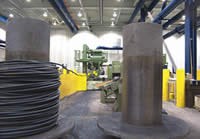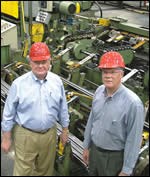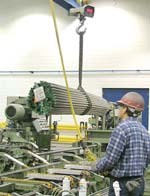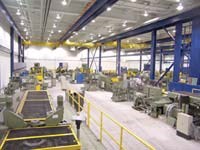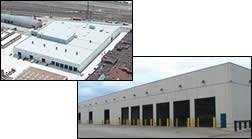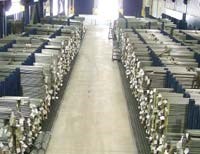Manufacturer Unveils Cold-Finished Steel Bar Facility
This is an exclusive look at a state-of-the-art cold-finished steel bar facility.
About 2,000 truckloads of concrete went into the construction of the building and its adjoining grounds. Its roof can hold a 100-year rain and slowly release the water to avoid swamping the area's storm sewers. It plugs into two separate electric power grids; should one go down, it can switch to the other to avoid long-term production shutdowns. Construction of the new facility began as steel prices collapsed, but the building was completed just in time to help manufacturing firms and precision machined part producers get through the great steel shortages of 2003 and 2004.
Corey Steel Co.'s Building 18 is a new, 110,000-square-foot addition to the company's Cicero, Illinois, complex, dedicated to producing cold-finished steel bar exclusively from hot-rolled coil. Although some customers and industry groups have toured the new facility since its completion in November, 2003, Production Machining is the first publication to provide an in-depth report on the facility. One of the advantages of our this tour is that you won't need safety glasses or a hard hat. We also spare you having to walk the length and breadth of Building 18, which represents about one-sixth of the company's total production area.
Corey has been producing cold-finished steel bar at its Cicero complex since 1951. Although the company has made numerous improvements to its production facility through the years, some of the machines were getting old. Rather than continue to put money into an aging plant and machinery, the company began thinking in terms of a completely new, more efficient production facility that allows the company to control all attributes of quality. The goal: to produce the best cold-finished steel bar available.
"It's not that the old machines didn't produce good bar," notes John Kenefick, Corey's vice president of sales and marketing. "They did. They just can't do what the new machines can do in terms of the overall quality of the cold-finished steel bar. At the same time, our older machines were limited in terms of the bar sizes we could produce from coil. To produce some of the larger bar sizes, we had to buy hot-rolled bars (straight lengths) and draw them into cold-finished bars. With the new machines, we can produce those larger sizes directly from coil with less scrap and handling. It's an oversimplification, but comparing the new facility to our former operation is like comparing a computer to an adding machine.
"lf you live in a house for many years and make improvements from time to time, you eventually reach a point where you say, ‘If I had it to do all over again, here's what I would do differently,'" Mr. Kenefick continues. "We had made improvements to our cold-finishing operation through the years, and living with the unanticipated consequences of those improvements provided our executive staff with a number of ideas for doing things differently. We incorporated many of those ideas in the new facility." Some of those ideas are covered in this article.
Coil Prep Area
The new facility is divided into three main areas. The first is a coil prep area where continuous coils of hot-rolled steel bar are brought in from outside storage and readied for the drawing operation. Workers load each hot-rolled coil onto one of two vertical uncoilers and thread it into a vertical and horizontal hot roll pre-straightener. From the hot roll pre-straightener, the continuous length of steel goes directly into a shot-blasting machine that removes rust and scale from the surface of the as-rolled raw material.
Although each of Building 18's six drawing lines begins with uncoiling, pre-straightening and shot blasting of the hot-roll coils, those operations are isolated (literally walled off) from the downstream operations. "The coil preparation operation is usually the dirtiest part of the process of producing cold-finished steel bar," Mr. Kenefick explains. "Because we had the luxury of designing the new facility from scratch, we elected to separate the coil preparation operations from the downstream drawing and finishing operations—something we could not do in our existing facility. As the bar emerges from the shot blasting machine, it goes through a funnel in the wall to the in-line continuous drawing machine on the other side, leaving behind the dust and grit resulting from the uncoiling and cleaning operations. The wall is there because the cleaner the product going into the die and the cleaner the environment that the product is produced in, the better the quality of the cold-finished steel bar."
Cold-Finishing Department
The second major area of Building 18 is the bar drawing and finishing department where the cleaned, hot-rolled, pre-straightened coil is drawn through a die to a specific diameter, straightened again, magnetically surface tested, sheared into bars of a specific length and straightened one final time. The process is highly automated: Once a coil is loaded onto an uncoiler, the material is not touched by an operator until it accumulates, creating cut-to-length finished bars at the exit end of the line. This is all done in line and automatically. Using an overhead crane, the operator removes bundles of bars from the end of the line for transfer to storage or to move processing along, if required.
The building's coil-to-straight length drawing department consists of six continuous drawing lines arranged side by side in order of bar size capacity. Three of the lines are built around existing re-engineered and rebuilt 11-metric-ton machines (the tonnage rating refers to the maximum pulling force that the machine can exert on the material when drawing it through the die) that Corey installed in the new facility. To its existing lines, the company added three new lines with 8-, 26- and 40-metric-ton machines respectively. The six cold-drawing lines in this building enable Corey to produce cold-finished steel bar in diameters from 1/4 inch to 2 inches directly from hot-rolled coil.
"We were able to produce cold-finished steel bars up to 4 inches in diameter before we acquired the new machines, but we couldn't draw sizes above 1 1/8 inches directly from hot-rolled coil," Mr. Kenefick explains. "Instead, we drew the bars from hot-rolled bars, which involved considerably more handling of the material and movement of the material through the plant. With our two new continuous drawing machines, which are the largest and next-largest machines available from Schumag AG, a German manufacturer, we can produce bars up to 2 inches in diameter more efficiently and more cost effectively directly from coil."
Mr. Kenefick says the new machines can run faster than their older cousins. However, he stresses that their most important benefit lies in a number of engineered refinements that improve the quality of the steel bar they produce. He cites greater use of electronics on the lines that make the closer monitoring of each component's functionality possible.
The new facility makes extensive use of historical data when setting up a line for a production run, thus reducing setup time and scrap. "Before, with the old equipment, the line operator would spend a lot of time measuring bar size and straightness and adjusting machine settings to get the desired results," explains Daniel Wilson, Corey's quality manager. "Now, we can instantly access information about a previous production run and use those optimized machine settings the next time we run the same bar grade and size. For example, setting the bar straightener's top and bottom roll angles and roll pressure used for the last job provides optimum straightness for the current job. Therefore, the production run starts with the correct settings and the process control settings are maintained throughout the production lot."
The improvements include the appearance of the bar. "In a manufacturing environment, working fluids such as coolants and lubricants tend to pick up contaminants," Mr. Lavery says. "We apply lubricant during the drawing operation and rust preventative oil at the final bar straightening operation and, as much as we try to keep the bar production area as clean as possible, there are still some particulates in the air that, over time, can contaminate the lubricants. If left untreated, the contaminated fluid can dull the bars' appearance.
"To avoid the problem, each of our drawing lines has a centrifuge that filters the rust preventative lubricant continuously," he explains. "Then, the new drawing lubricant and processed rust preventative oil we apply to the bar at the drawing die and straightening operation respectively, are clean at all times. That enables us to provide high quality, bright cold-finished steel bars."
Bar Storage Area
The third major area of the new facility is the storage area, which is capable of accommodating more than 8,000 tons of cold-finished steel bar. When added to its existing storage capacity, Corey has the ability to inventory finished product on a basis consistent with established master scheduling criteria. Where many of its customers view material inventory as an operating cost to be minimized as much as possible, the company sees it as an important asset. "Inventory is a good thing as long as it is managed correctly," Mr. Kenefick says. "Maintaining the correct amount of inventory allows us to schedule economical and efficient runs of a particular size or group of sizes. Master scheduling is definitely beneficial for the company and our customers because it allows us to invest in the right quantity of the right items at the right time."
Good Timing After All
"Before we started construction on the new facility in late 1999, we studied the market and everything seemed to be right," Mr. Kenefick recalls. "Then, everything fell apart. The market wasn't very good, the margins weren't very good, and prices were bad worldwide. The period from 2001 to early 2002 turned out to be one of the most difficult economic times for the steel industry in recent history.
"We survived that difficult time, and when everything turned around in late 2003, we were poised and ready," he continues. "The new facility provided us with the capabilities we needed to be able to supply our customers' needs in 2004. We went into that very tight, strong market with more inventory than many of our competitors. That buffered us through 2004 in terms of being able to help our customers put out fires. The new facility significantly improved our ability to quickly convert hot-rolled coil deliveries into bar to maintain our inventories and keep our customers supplied with steel. Did we have a hard time keeping some of our "A" items (more popular items) at the levels we wanted? Yes, but never to the point where we couldn't meet our customers' needs."
Although Corey's new facility includes more drawing lines capable of higher operating speeds, company management, starting from the top, insists that quality is the number one consideration. "We are not interested in making as much bar as we can or making it as fast as we can. We want to make the best bar that we can," President Paul Darling explains. "The most important aspect of our new machines is that they can produce cold-finished steel bar with more consistency in all of the attributes of quality—and do it at significantly higher speeds.
"Our customers are required to produce zero-defect parts and assemblies for their customers, and we recognize the need to provide them with products of consistent quality," Mr. Darling continues. That is why we make a concerted effort to control every aspect of the production process.
"We try to instill quality in everything we do at Corey," he says. "It is much more efficient to produce, handle and ship bars, and process documentation under strict quality guidelines than to inspect for quality at the end of every process.
Corey's commitment to quality is reflected in part in its certification awards. The company's QS 9000 certification was due to expire, so its management team decided to go for two certifications at the same time. The company completed the third-party registration audits and has just been certified for the ISO 9001:2000 Quality Management System Standard and the ISO 14001:2004 Environmental Management System Standard.
Read Next
A Tooling Workshop Worth a Visit
Marubeni Citizen-Cincom’s tooling and accessory workshop offers a chance to learn more about ancillary devices that can boost machining efficiency and capability.
Read MoreEmerging Leaders Nominations Now Open
Here’s your chance to highlight a young person in your manufacturing business who is on the path to be a future leader moving your company forward.
Read MoreDo You Have Single Points of Failure?
Plans need to be in place before a catastrophic event occurs.
Read More




.jpg;width=860)
